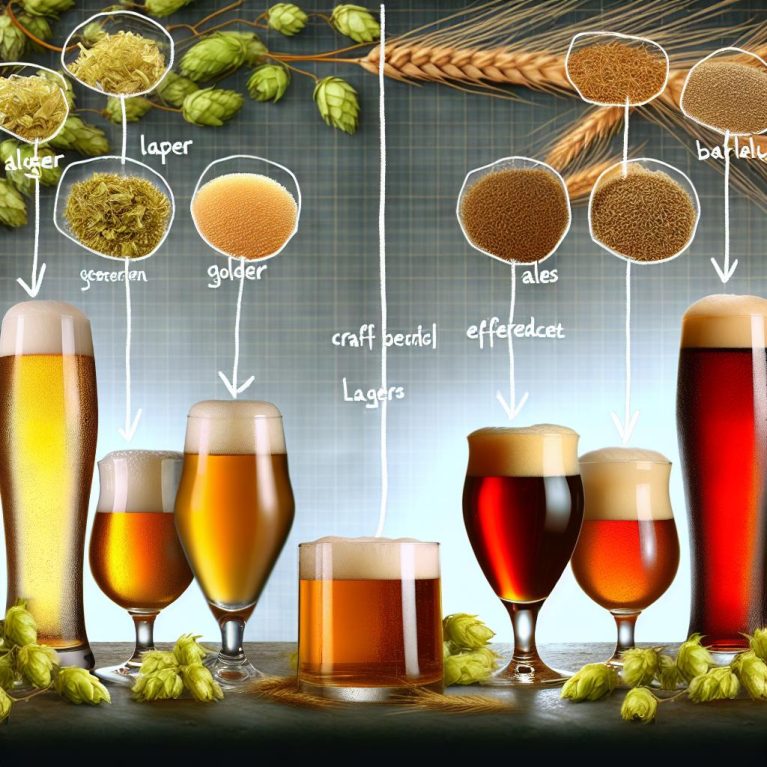The Basics of Beer: Lagers vs. Ales
In the ever-growing and varied world of craft beer, understanding the contrast between lagers and ales is a fundamental aspect that provides insight into beer production and flavor differentiation. This distinction, primarily driven by the yeast types used and their fermentation processes, underpins an array of flavors and experiences that appeals to a wide audience from casual drinkers to seasoned connoisseurs. Grasping these differences can enhance one’s appreciation and exploration of the nuances of craft beer.
Yeast and Fermentation Process
The role of yeast in the brewing process cannot be overstated as it is directly responsible for converting sugars into alcohol and carbon dioxide. This transformation is central to brewing, and the choice of yeast significantly influences the flavor and character of the beer produced.
Lagers are brewed with bottom-fermenting yeast known scientifically as Saccharomyces pastorianus. This yeast works effectively at cooler fermentation temperatures, typically ranging from 45°F to 55°F (7°C and 13°C). The fermentation process for lagers is slower and occurs under these colder conditions, promoting the development of a clean, crisp taste that many beer enthusiasts associate with lagers. The slow, cool fermentation allows for the production of fewer byproducts, which gives lagers their characteristic milder taste.
By contrast, ales make use of top-fermenting yeast, specifically Saccharomyces cerevisiae. This yeast strain ferments at warmer temperatures, generally between 60°F and 72°F (15°C and 22°C). Under these warmer conditions, fermentation occurs more rapidly, and the resulting beer often contains more complex flavors due to the higher production of esters and phenols. These compounds contribute a wide range of flavors and aromas, from fruity to spicy, that intensify the breadth of the ale’s profile.
Flavor Profiles
The influence of fermentation methods on flavor is profound, leading to distinguishable profiles between lagers and ales. Lagers are celebrated for their clean, crisp flavors and muted complexity. Due to the colder fermentation and resulting suppression of additional compounds in the final product, lagers typically exhibit a smoothness and are frequently described as refreshing. This makes them a popular choice among those who prefer a straightforward and easy-drinking experience.
On the other hand, ales offer a more complex and robust flavor profile. The warm fermentation temperature encourages the yeast to generate a variety of fruity, spicy, or floral notes, adding layers to the taste. This greater complexity often imparts a richer and more aromatic character with a fuller body, distinguishing ales from their lager counterparts. Ale enthusiasts appreciate the diversity of flavors that can manifest in different ale styles, offering versatility for those who enjoy experimenting with their beer selections.
Examples and Styles
Within the lager category, several styles stand out, each offering unique takes while staying true to the lager’s defining characteristics. Examples include:
– **Pilsners**: Known for their pale, golden appearance and crisp, clean taste, Pilsners offer subtle hop bitterness and are a quintessential lager style.
– **Bocks**: These are traditionally stronger lagers with a robust malt flavor, often enjoyed seasonally.
– **Märzens**: Typically brewed for Oktoberfest, these lagers are medium-bodied with a rich, malty profile and a clean finish.
For those leaning towards ales, a multitude of styles are present to provide an extensive flavor wheel, such as:
– **Pale Ales**: Featuring a balanced hop-to-malt ratio, they present light to moderate bitterness and are a staple in many craft beer lineups.
– **IPAs (India Pale Ales)**: Notable for their intense hop aroma and strong, bitter taste, IPAs are a favorite among hop enthusiasts.
– **Stouts and Porters**: These dark ales boast rich flavors, ranging from coffee and chocolate to toasty and nutty notes, offering a heavier, more full-bodied experience.
Exploring Further
For those curious about further exploring the varieties of lagers and ales, visiting local breweries provides a valuable opportunity. Many breweries offer tours and tasting sessions where individuals can engage with the brewing process and sample different styles. Learning directly from brewers provides firsthand insight into the craft, bridging the gap between brewing theory and practice.
Additionally, as the craft beer scene continues to innovate, exploring a range of beers online can complement experiential learning. Numerous online resources delve into specific beer styles, though it is beneficial to seek out content that prioritizes detailed, technical information over anecdotal experiences to better understand the intricacies of beer production.
In conclusion, while the choice between lagers and ales is largely a matter of personal preference, understanding the foundational differences in their fermentation processes and the resulting flavors can significantly enhance one’s appreciation for the complexities of beer. Rather than simply choosing based on taste, an informed approach can open up a world of possibilities, making the journey into beer exploration both enlightening and thoroughly enjoyable.

